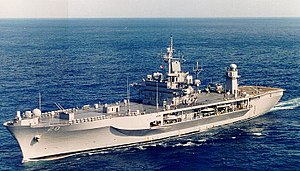USS Mount Whitney
This article needs additional citations for verification. (January 2009) |
 USS Mount Whitney (LCC/JCC 20)
| |
| History | |
|---|---|
| Name | USS Mount Whitney |
| Ordered | 10 August 1966 |
| Builder | Newport News Shipbuilding & Drydock Company |
| Laid down | 8 January 1969 |
| Launched | 8 January 1970 |
| Commissioned | 16 January 1971 |
| Homeport | Gaeta, Italy |
| Status | in active service |
| General characteristics | |
| Displacement | 18,400 tons full load |
| Length | 189 metres (620.1 ft) |
| Beam | 33 metres (108.3 ft) |
| Draft | 906.78 centimetres (29.8 ft) full load |
| Propulsion | Two boilers, one geared turbine |
| Capacity | 930 |
| Complement | 170 officers and enlisted men; and 155 Military Sealift Command civilian sailors |
| Armament | list error: <br /> list (help) Two Phalanx CIWS Two 25 mm Bushmaster cannons Four .50 cal. machine guns, Mark 36 SRBOC chaff rockets |
| Aircraft carried | One helicopter, currently a SH-60 Knight Hawk |
The USS Mount Whitney (LCC/JCC 20) is a Blue Ridge class command ship of the US Navy; it is the flagship of the Sixth Fleet. She is also the command and control ship for the Commander Joint Command Lisbon and the Commander Striking Force NATO. She had previously served for years as the COMSTRIKFLTLANT(NATO Designation) / Second Fleet's command ship.
She was classified as the LCC-20 on 1 January 1969, and she was laid down on 8 January by Newport News Shipbuilding & Drydock Company, Newport News, Virginia.
Etymology
The ship is named for Mount Whitney, a peak in the Sierra Nevada mountain range of California. Mount Whitney is the highest summit in the contiguous United States with an elevation of 14,505 feet (4,421 m).[1]
Capability
Considered by some to be the most sophisticated Command, Control, Communications, Computer, and Intelligence (C4I) ship ever commissioned, Mount Whitney incorporates various elements of the most advanced C4I equipment and gives the embarked Joint Task Force Commander the capability to effectively command all units under his or her command.
The Mount Whitney can transmit and receive large amounts of secure data to and from any point on earth through HF, UHF, VHF, and SHF (satellite communications) communications channels. This electronic technology enables the Joint Intelligence Center and Joint Operations Center to provide the most timely intelligence and operational support available in the Navy.
Deployments
From 1981 to 2005, Mount Whitney served as Flagship for Commander Second Fleet/Commander Striking Fleet Atlantic. In this role she spent much of her time berthed at Norfolk rather than underway, earning her the nicknames "Building 20" and "Pier 11½".
The Mount Whitney deployed in 1994 to Haiti with LTG Hugh Shelton, the commander of the XVIII Airborne Corps, in command of the Joint Task Force that conducted Operation Uphold Democracy.
On 12 November 2002, Mount Whitney deployed to the Central Command area of responsibility in support of Operation Enduring Freedom. She was acting as the initial command post for Combined Joint Task Force - Horn of Africa. During the deployment, the ship embarked elements of the 2nd Marine Division and II Marine Expeditionary Force (II MEF), based at Camp Lejeune, North Carolina, under the command of Maj. Gen. John F. Sattler and Captain Morton W. Kenyon.
In 2004, Military Sealift Command civilian sailors were integrated into her crew. She remains a commissioned warship in the United States Navy, but the size of her crew was reduced from about 600 sailors to about 170 Navy officers and enlisted men and 155 civilians.
In February 2005, Mount Whitney left Norfolk for Gaeta, Italy where she was redesignated as the (LCC/JCC 20) and assumed duties as the 6th Fleet flagship, officially relieving La Salle. She also assumed duties as the command ship for the Commander Joint Command Lisbon and the Commander Striking Force NATO.
In August 2008, Mount Whitney was deployed to the Black Sea in support of Operation Assured Delivery to deliver humanitarian aid to those affected by the Russian-Georgian war [2] and became the first NATO ship to deliver aid to port of Poti, Georgia.[3]
On 6 November 2008, Mount Whitney was unable to enter the port at Sevastopol. The city authorities and representatives of Ukrainian Navy wouldn't comment on the event. Sources in the City Administration only reported that the US ship's visit failed due to problems with border crossing documents. However it is more likely that anti-NATO protests may have been the cause.[4][5]
Ongoing from March 19, 2011, Mount Whitney served in the Mediterranean as the main command vessel for the enforcement of United Nations Security Council Resolution 1973 against Libya,[6] flagship for Admiral Samuel J. Locklear, who has tactical command of the Operation Odyssey Dawn joint taskforce. [7] Command is expected to be transferred to a coalition commander in time[8] though confusion within the coalition was evidenced in early days.[7] The vessel is serving as a command-and-control vessel for the United States' involvement in the coalition campaign aimed to enforce a Libya no-fly zone and to stop Muammar Gaddafi's forces from destroying the rebel stronghold of Benghazi.[9]
References
- ^ "NGS data sheet. U.S. National Geodetic Survey. http://www.ngs.noaa.gov/cgi-bin/ds_mark.prl?PidBox=GT1811. Retrieved 2011-02-28"
- ^ [1] [dead link]
- ^ http://news.bbc.co.uk/2/hi/europe/7599919.stm
- ^ http://photo.ukrinform.ua/eng/current/photo.php?id=236279
- ^ http://lenta.ru/news/2008/11/07/rally/
- ^ http://blogs.aljazeera.net/live/africa/libya-live-blog-march-19
- ^ a b MacAskill, Ewen and Nick Hopkins, “Libyan operation hampered by confusion and dispute: Lack of resolution over who will take control of military operation tests patience of US”, The Guardian 21 March 2011 18.59 GMT. Retrieved 2011-03-21.
- ^ http://www.cnn.com/2011/WORLD/africa/03/19/libya.civil.war/index.html?hpt=T1&iref=BN1
- ^ http://news.yahoo.com/s/ap/us_us_libya
External links
- USS Mount Whitney official Site
- Photos
- navysite.de: USS Mount Whitney
- USS Mount Whitney (LCC-20) command histories – Naval History & Heritage Command
